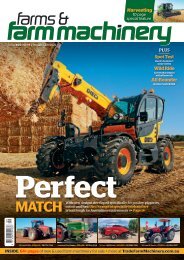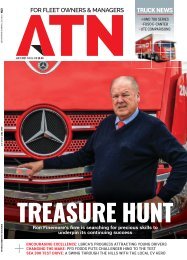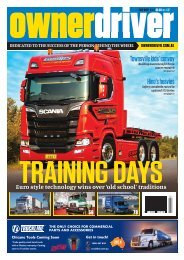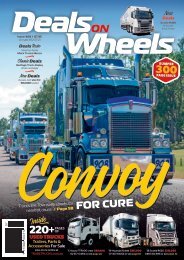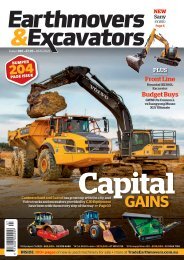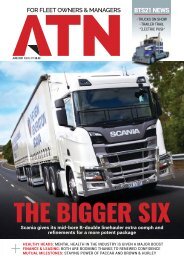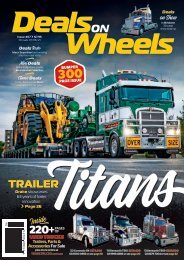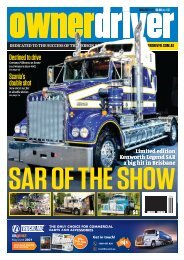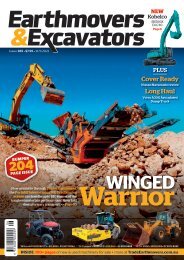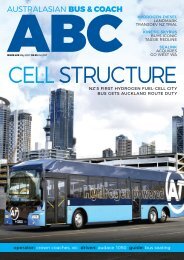Deals on Wheels #469
Create successful ePaper yourself
Turn your PDF publications into a flip-book with our unique Google optimized e-Paper software.
New DEALS<br />
It all started with the company <strong>on</strong>ce known<br />
as Mercedes-Benz Australia (MBA) and,<br />
critically, a handful of senior executives who<br />
saw immense potential for a new breed of<br />
US c<strong>on</strong>venti<strong>on</strong>al suitably tailored to local<br />
c<strong>on</strong>diti<strong>on</strong>s.<br />
Ir<strong>on</strong>ically, the gap in the market left by<br />
White’s departure would be <strong>on</strong>e of many<br />
motivati<strong>on</strong>s for MBA’s interest in Freightliner,<br />
but no motivati<strong>on</strong> was greater than the desire<br />
to simply add a North American c<strong>on</strong>venti<strong>on</strong>al<br />
to its entrenched range of Mercedes-Benz<br />
cab-overs.<br />
Choosing the right Freightliner model was<br />
no straightforward task, though. Nor would it<br />
be a quick decisi<strong>on</strong> by the various executive<br />
voices within MBA, led largely, and somewhat<br />
forcefully, by the late Ian Bruce, who would<br />
become rightfully regarded by many as the<br />
‘Father of Freightliner in Australia’.<br />
Understandably, the excitement within<br />
MBA’s Mulgrave (Vic) headquarters after<br />
Daimler-Benz’s 1981 purchase of Freightliner<br />
was almost palpable. C<strong>on</strong>sequently, it wasn’t<br />
l<strong>on</strong>g before a small group from Mulgrave’s<br />
upper echel<strong>on</strong>s boarded a plane bound for<br />
Freightliner HQ in Portland, Oreg<strong>on</strong>.<br />
It’s worth noting at this point that<br />
Freightliner had a well-deserved reputati<strong>on</strong><br />
for innovative engineering. The brand was<br />
founded in 1942 and its founder, Leland<br />
James, was a prominent US fleet owner who<br />
apparently viewed truck development as a<br />
somewhat natural fit for greater productivity<br />
in a road transport fleet.<br />
In the late ‘50s, for example, the brand was<br />
first to develop a cab-over able to tilt through<br />
a full 90 degrees and was an even earlier<br />
adopter of aluminium in cab c<strong>on</strong>structi<strong>on</strong>.<br />
Ir<strong>on</strong>ically, though, from the ‘50s into the<br />
‘70s, Freightliners were sold in the US through<br />
the White network, even bearing a ‘White<br />
Freightliner’ badge, until White hit hard times<br />
and necessity drove Freightliner to assemble<br />
its own sales and service outlets.<br />
Freightliner’s l<strong>on</strong>g list of innovative<br />
achievements definitely wasn’t lost <strong>on</strong> the<br />
ambitious Australian group, who headed to<br />
Portland to not <strong>on</strong>ly search for a c<strong>on</strong>venti<strong>on</strong>al<br />
c<strong>on</strong>tender, but also appraise Freightliner’s<br />
willingness to satisfy a right-hand drive<br />
market for the first time.<br />
It wasn’t l<strong>on</strong>g before a possible candidate<br />
was found in the form of an FLC120 model<br />
and, with excitement and c<strong>on</strong>victi<strong>on</strong> in<br />
abundance, MBA ordered two trucks for<br />
extensive testing in Australian c<strong>on</strong>diti<strong>on</strong>s.<br />
The pair of aluminium FLC120s (120-inch<br />
[304.8cm] bumper to back-of-cab) were said<br />
to be the first right-hand drive units built<br />
in Freightliner’s Portland factory and, by<br />
mid-1982, they’d landed in Australia for what<br />
would develop into a l<strong>on</strong>g and arduous<br />
test regime.<br />
While these events were supposedly<br />
unfolding with a high degree of secrecy,<br />
excitement in the MBA camp was difficult to<br />
c<strong>on</strong>tain. Even Bruce’s usual cauti<strong>on</strong> started<br />
to wilt and it’s still easy to recall a quiet but<br />
intensely deliberate discussi<strong>on</strong> during a visit<br />
to Mulgrave in the early ‘80s.<br />
Quizzed about Freightliner’s potential for<br />
Australia, an anxious ‘Brucey’ first sought<br />
repeated assurances that c<strong>on</strong>fidentiality<br />
would be respected before eventually leading<br />
the way to a n<strong>on</strong>descript building where <strong>on</strong>e<br />
of the two ‘secret’ FLC120s was undergoing<br />
engineering evaluati<strong>on</strong>.<br />
“Well, what do you think?” he asked after<br />
a few minutes and, if memory serves me<br />
right, the initial resp<strong>on</strong>se was al<strong>on</strong>g the<br />
lines of: “It’ll be interesting to see how that<br />
aluminium cab and all those pop rivets<br />
stand up to our c<strong>on</strong>diti<strong>on</strong>s.”<br />
He immediately agreed, explaining that<br />
the other unit was already undergoing hard<br />
tests. Indeed it was, first at the M<strong>on</strong>egeeta<br />
(Vic) military proving grounds and, later,<br />
severe <strong>on</strong>-road tests around Wilcannia in<br />
far western NSW.<br />
Requests to drive <strong>on</strong>e of the trucks were<br />
met with polite but definite refusal. In fact,<br />
it would take almost 40 years before the<br />
opportunity to drive <strong>on</strong>e of those two trucks<br />
presented itself and, as fate would have it, just<br />
a few hundred kilometres west of Wilcannia.<br />
Meanwhile, <strong>on</strong>going US developments<br />
were giving the Mulgrave mob plenty of<br />
other things to think about bey<strong>on</strong>d the two<br />
trucks being tested here. Under Daimler’s<br />
In a wise move, Australia’s<br />
first Freightliner was the<br />
highly durable FLC112<br />
145




